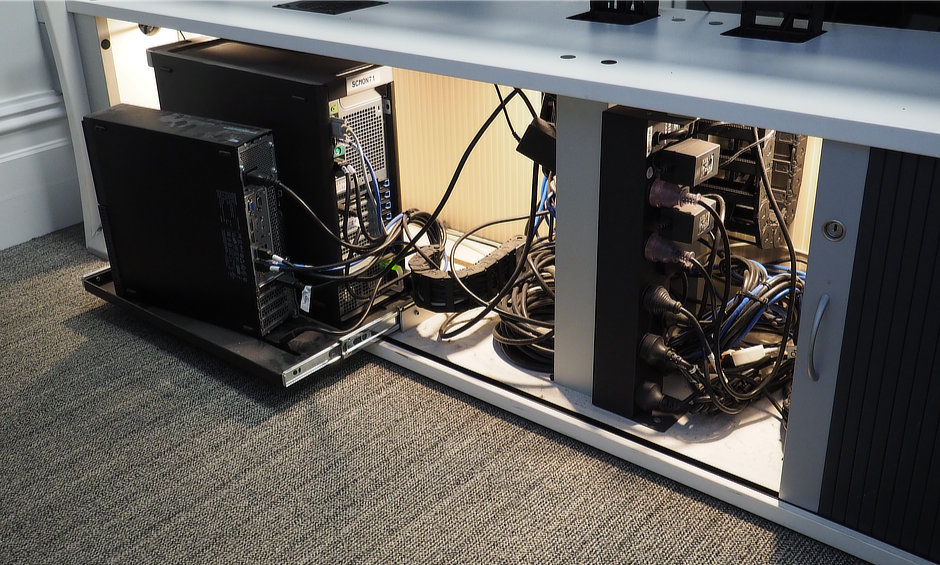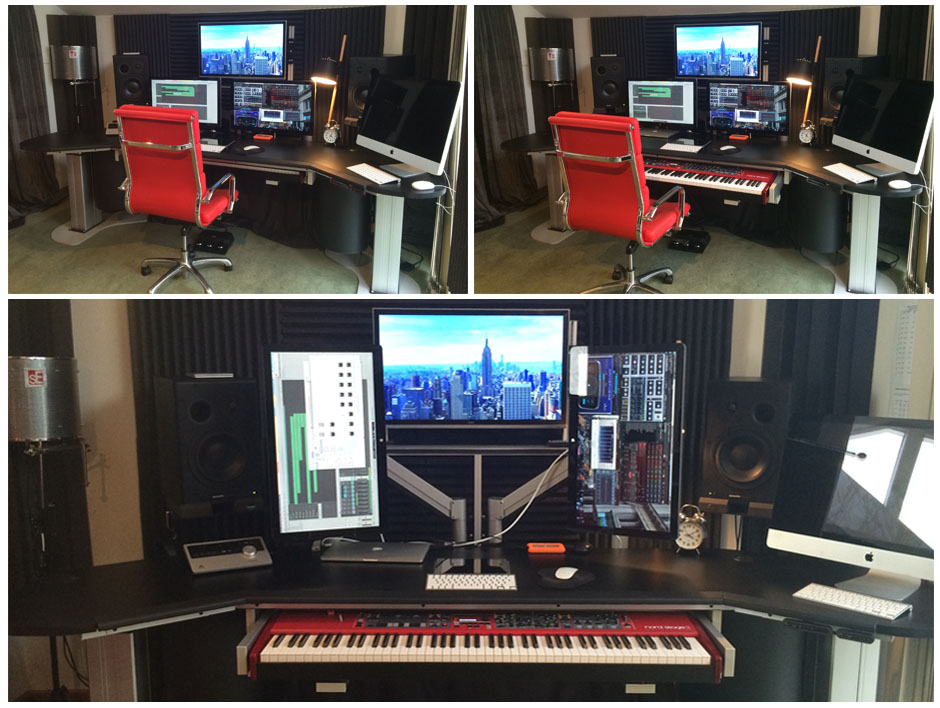- Home
- Benefits of Addressing OH&S Issues in the Control Room, Office and Studio Environments With Improved Workstation Design
Muskuloskeletal Disorders and Workstations
Control room operators, office workers and a range of music professionals perform a majority of their work at a workstation. A poorly designed workstation can lead to a number of muskuloskeletal disorders (MSDs) through cumulative trauma. Marras (2012) defines cumulative trauma as repeated application of force to a structure that tends to wear down a structure beyond its tolerance limit, presented in Figure 1 below.

This cumulative trauma can lead to inflammation and swelling of tendons and muscles, reduced motion, strength, mobility and microtrauma of muscle fibres resulting in partial tears (Marras, 2012). Healing time for a muscle can take 10 days while a tendon could take 20 times longer (Marras, 2012).
Work performed in a seated position puts the worker at greater risk of spine loading and damage, while prolonged standing may result in static overload (Marras, 2012). In a 2002 study; Marcus et al. found relationships between certain static postures while sitting at a workstation and the development of MSDs.
There is an abundance of statistical data reflecting the severity of the MSDs issue in the workplace. According to 'Safe Work Australia - Key Work Health and Safety Statistics 2012', the most common work-related injuries were sprain and strains, at 43% of all serious claims. Safe Work Australia has identified MSDs as a high priority disease group. The '2009-2010 ABS Work Related Injuries' report lists sprains/strains and chronic joint or muscle conditions as the most commonly reported work-related injury or illness sustained across the majority of industries. It is estimated that the total cost of MSDs is 20 billion dollars annually (Kothiyal and Folland, 2007).
The 'Occupational Health and Safety Regulations 2007 S.R. No. 54/2007', states that an employer, when determining any measure to control any risk of MSDs, must address the following factors:
a. posture;
b. movements;
c. forces;
d. duration and frequency of the task;
e. environmental conditions
The control room should be designed with a high level of comfort to increase the possibility of operators remaining awake and alert (Ivergard and Hunt, 2009, p. 349). According to Krakowski (2006) it is possible to minimise or eliminate work-related injuries to the musculoskeletal system through redesign of a workstation. According to Das (2006), an ergonomically designed workstation can enhance worker physical and mental well being, job satisfaction and safety.
As highlighted in the 2006 'Worksafe - Officewise - A guide to health & safety in the office', "electric height adjustment of the workstation is most appropriate". Kothiyal and Folland (2007) explain that allowing workers to change working postures during prolonged work can have significant beneficial effects on the productivity and health of the worker. Hedge (2004) and Goel et al. (1999) acknowledge there are physiological advantages in alternating between sitting and standing.

"The desk is so beautiful .. I LOVE IT .. and it makes working so much more pleasurable, and the long hours currently required much more comfortable! I am thrilled !! "
- David Hirschfelder
Musician, film score composer and performer.
1996 Oscar nominee, AFI and an APRA award winner for his 'Shine' score.
1998 Oscar nominee, as well as a BAFTA award for his 'Elizabeth' score.
Recognised globally as Australia's most distinguished and renowned screen-composer.
Noise and Vibration
Worksafe Victoria's noise exposure standard is a level of 85dB at the employees ear, over an eight hour period, with a peak level of 140dB. The 'Occupational Health and Safety Regulations 2007 S.R. No. 54/2007', states that "an employer must ensure that no employee at the workplace is exposed to noise that exceeds the noise exposure standard". According to 'Safe Work Australia - Key Work Health and Safety Statistics 2012', sound and pressure attributes to 4.2% of injury/disease and noise-induced hearing loss is listed as a priority disease group.
According to Ivergard and Hunt (2009), the levels of noise (undesirable sound) present in control rooms are not generally high enough to cause hearing damage, however considerable disturbance can be caused by noise which can lead to OH&S incidents.
Noise in control rooms can arise from sources within the room such as fans and computers. There are external sources, especially when the control room is attached to the structure of the building in which the industrial process being controlled takes place. This process may produce vibration which is transmitted through the walls (Ivergard and Hunt, 2009, p. 194). In this scenario the noise needs to be monitored for excessive levels of above the 85dB standard.
Ivergard and Hunt (2009) explain that the most important problem with control room noise is that the noise disturbs communication between people and also makes it difficult for the operators to hear the various signals from both the control equipment and directly from the process. In order for speech to be heard (commonly lies between 60 and 65 dB), the background noise level in the control room should not exceed 60dB.
As highlighted by the 1977 Teneriffe runway collision that killed 335 people, the communication between controllers and other worker's is critical to ensure health and safety (Weick, 1990).
The 2006 'Worksafe - Officewise - A guide to health & safety in the office', explains 'noise that prevents a person from understanding an instruction or warning signal may be risky, and should be kept as low as possible'. There are three main points at which noise can be reduced (Ivergard and Hunt, 2009, p. 197):
1. Source
2. Pathway
3. Receiver
The noise should be reduced as much as possible at the source using the following methods (Ivergard and Hunt, 2009, p. 197):
1. Forces that cause vibration should be localised
2. Resonance should be stopped
3. Reducing area of vibrating parts
4. Changing fixing positions of the vibrating parts
5. Using acoustically-absorbent linings
Where the noise cannot be reduced at the source, for example computer fans or other hardware, a block of the pathway with the help of enclosures (pictured below) is a sufficient method (Ivergard and Hunt, 2009, p. 197).

Noise reduction at the receiver with the aid of hearing protectors should be avoided in control rooms, unless noise reduction can not be achieved by other means, as this will cause communication problems (Ivergard and Hunt, 2009, p. 197).
Ergonomics
Ergonomics describes the interaction between the operator and the demands of the task being performed. The main concern is to try and reduce unnecessary stress in these interactions. When designing an ergonomic height adjustable console, Console Concepts focuses on people's behaviour as they interact with equipment and their environment, as well as operator size and strength capabilities. Console Concepts ergonomic consoles are height adjustable at the touch of a button and take into account all of the following factors:
- forward reach capability and shoulder height to determine where objects can be located
- monitor viewing angle and distance to ensure there is no unnecessary load on neck, shoulders and upper spine for sitting or standing
- elbow height
- thigh clearance
- optimal working height of the hands
- height of work surface
- leg clearance
- knee clearance
- footrest knee clearance
- work surface thickness
- foot depth clearance
All our ergonomic height adjustable workstations are easy to use and can be adjusted to the user's most comfortable working positions. Every electric height adjustable desk can be raised or lowered at the touch of a button to change the posture to either sitting or standing positions. Our extensive range of monitor mounting solutions ensure operators can adjust the monitor height, position, tilt, pan, and landscape to portrait. Optional front padded surfaces or rolled edges improve wrist and arm comfort by eliminating hard and sharp edges. Hidden cable design and easy access to power and data create a clutter free environment. Secure hardware storage as well as easy access to the hardware ensures maintenance tasks can be performed swiftly, safely and effectively.

References
Ivergard, T.. & Hunt, B. (2009) Handbook of Control Room Design and Ergonomics: A Perspective for the Future. Florida: Taylor and Francis Group
Karwowski (2006) International Encyclopedia of Ergonomics and Human Factors Volume 1 - Second Edition. In Kerns, K. (Ed.), Air Traffic Management System Design (pp. 2041- 2048) Florida: Taylor and Francis Group
Karwowski (2006) International Encyclopedia of Ergonomics and Human Factors Volume 1 - Second Edition. In Das, B (Ed.), Ergonomic Workstation Design (pp. 1596- 1607) Florida: Taylor and Francis Group
Kumar, S. (1999) Biomechanics in Ergonomics. In Goel, V.K., Montogmery, N.M., Grosland, M.H., Pope, M.H., Kumar, S. (Eds), Ergonomic Factors in the workplace contribute to disc degeneration (pp. 243- 265) London: Taylor and Francis Group
Skjerve, A.B., & Bye, A. (2011) Simulator-based Human Factors Studies Across 25 Years - The History of the Halden Man-Machine Laboratory Florida: Springer-Verlag Berlin Heidelberg
Salvendy, G. (2012) Handbook of Human Factors and Ergonomics. In Marras, W. (Ed), Basic Biomechanics and Workstation Design (pp. 347-381) New Jersey: John Wiley & Sons, Inc.
Weick, K.E. (1990) The Vulnerable System: An Analysis of the Tenerife Air Disaster Michigan: Journal of Management
Marcus, M., Gerr, F., Monteilh, C., Ortiz, D., Gentry, E., Cohen, S., Edwards, A., Ensor, C., Kleinbaum, D. (2002) A prospective Study of Computer Users: II Postural Risk Factors for Musculoskeletal Symptoms and Disorders Atlanta: American Journal of Industrial Medicine, Vol 41, 236-249
Dawson, D., & Reid, K. (1997) Fatigue, alcohol and performance impairment London: Nature Journal, Vol 388
Pryor, P. & Capra, M. (2012) Psychosocial Hazards and Occupational Stress, Tullamarine VIC: Safety Institute of Victoria
Paterson, J.L., & Dawson, D. (2012) Fatigue: The Core Body of Knowledge for Generalist OHS Professional, Tullamarine VIC: Safety Institute of Victoria
Dawson, D., & McCulloch, K. (2005) Managing fatigue: It's about sleep, Woodville: Sleep Medicine Reviews (2005) 9, 365-380
Akerstedt, T. (2003) Shift work and disturbed sleep/wakefulness Stockholm: Occupational Medicine, Vol 53 No. 2
Kothiyal, K., & Folland, C. (2007) Muscle load and discomfort in counter workstations users Sydney: University of New South Wales 'The Eighth Pan-Pacific Conference on Occupational Ergonomics
Folkard, S., & Tucker, P. (2003) Shift work, safety and productivity Paris: Occupational Medicine, Vol. 58 No.2
Tucker, P. (2003) The impact of rest breaks upon accident risk, fatigue and performance: A review. Florida: Taylor and Francis Group
Mitler, M.M., Carskadon, M.A., Czeisler, C.A., Dement, W.C., Dinges, D.F., Graeber, R.C. (1988) Catastrophes, Sleep, and Public Policy, Consensus Report La Jolla: Scripps Clinical and Research Foundation
Robertson (2011) Ergonomics and Health Aspect of Work with Computers. Florida: Springer-Verlag Berlin Heidelberg
Hedge, A. (2004) Effects of electric height-adjustable worksurface on self-assessed musculoskeletal discomfort and productivity in computer workers New York: Cornell University Human Factors and Ergonomics Research Laboratory Technical Report 0904
Costa (2003) Shift work and occupational medicine: an overview Verona: Department of Medicine and Public Health
Miller, N.L., Matsangas, P., Shattuck (2007) Fatigue and its Effect on Performance in Military Environments Naval Monterey: Postgraduate School Operations Research Department
Chengalur, S. Rodgers, S. Bernard, T. (2004) Kodak's Ergonomic Design for People at Work. New Jersey: John Wiley & Sons, Inc.
Occupational Health and Safety Act 2004 (VIC)
Worksafe Victoria (2007) Occupational Health and Safety Regulations 2007. Retrieved from http://www.legislation.vic.gov.au
Worksafe Victoria (2006) Officewise - A guide to health & safety in the office. Retrieved from http://www.worksafe.vic.gov.au/__data/assets/pdf_file/0016/3634/Officewise_web.pdf
